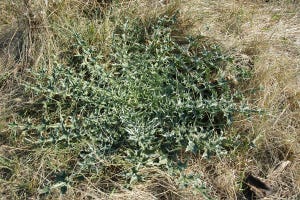Addressing Pasture Issues This Fall Can Pay Off Next Spring
When it comes to weed control, fall herbicide applications can help us reclaim more acres than ever.
October 6, 2014

While abundant moisture always is welcome, it prevented timely pasture spraying in many areas. Then, good rainfall through late summer germinated new weed flushes. That’s left us with some catching up to do. Fortunately, fall is a great time to do just that.
Start by reflecting on the grazing season. What worked well? Are there problem areas? Were you satisfied with how your cattle and pastures performed? Many issues — including weeds, brush and other low-value undesirable plants are an indication that something is amiss with your grazing program. Now is an excellent time to evaluate grazing programs, the need for additional cross fencing, fertility and weed control.
When it comes to weed control, fall herbicide applications can help us reclaim more acres than ever. Cooler weather, along with existing moisture, already is bringing a wave of thistle rosettes and Canada thistle regrowth. Stand by and watch all those thistles grow and you’ll have a wall of purple come spring.

Musk thistle is a biennial plant, meaning it produces these rosettes during its first year, often during the late summer and fall. Rosettes are especially susceptible to herbicides, which can be applied during the fall.
Thistles compete aggressively with forages for valuable water and nutrients. Grasslands weakened by overgrazing or other stresses are particularly vulnerable. While dense, healthy grass stands help suppress thistles, they aren’t immune. Even light infestations can have a major impact on forage utilization and carrying capacities. But when they reach moderate to dense levels, the production losses can be astronomical.
Fall is the most economical and most effective time to treat these prickly pasture pests. In the fall, biennial thistle rosettes are small and tender, so control requires less herbicide than waiting until next spring. And perennial Canada thistle is preparing for winter so herbicide uptake is high, resulting in more complete control. Generally calm, more predictable fall weather makes application easier, plus, you and your custom applicator typically have more time and a wider application window.
When selecting a herbicide for fall pasture spraying, consider a product with residual control, such as ForeFront® HL or GrazonNext® HL herbicide (depending on your location). These options bring a unique chemistry to broadleaf weed control, offering superior thistle control, plus residual control that can stop new weeds well into next spring. Applied this fall at 1.5 pints per acre for musk, bull and plumeless thistles and 2.1 pints per acre for Canada thistle, horseweed (marestail), henbit, chickweed and knapweeds, ForeFront HL or GrazonNext HL can prevent a lot of headaches next spring.
And, because you can apply either product up to the water’s edge along creeks, streams and stock ponds, they prevent those headaches in areas where weeds often thrive. Plus, there are no grazing restrictions for any class of livestock, even lactating dairy animals.† And, because they are not federally Restricted Use Pesticides, you won’t need a license to purchase or apply it.1 Fall applications will wipe out this season’s thistles. Then their residual activity will stop new rosettes and seedlings, plus other weeds, into next spring — allowing grasses to get off to a great start.

Because Canada thistle is a perennial, it is more difficult to control. However, it is easiest to control while it is young and lush. Treat fall seedlings or regrowth to eliminate the problem before it can do harm next spring.
The long-term benefits are significant, too. Effective thistle control helps pasture grasses to establish a thicker, more robust cover, which can prevent future infestations, boost forage production and improve property values. Considering the market opportunities ahead in the cattle industry, it makes sound business sense to ensure your pastures are at optimum production, allowing you maximum flexibility.
For more information about fall pasture spraying or ForeFront HL, contact your local ag-chem dealer or visit www.ForeFrontHerbicide.com or www.GrazonNextHerbicide.com.
†Label precautions apply to forage treated with ForeFront HL and to manure from animals that have consumed treated forage within the last three days. Consult the label for full details.
1Some states require an individual be licensed if involved in the recommendation, handling or application of any pesticide. Consult your local Extension office for information regarding licensing requirements.
®Trademark of The Dow Chemical Company (“Dow”) or an affiliated company of Dow. ForeFront HL is not registered for sale or use in all states. Contact your state pesticide regulatory agency to determine if a product is registered for sale or use in your state. Always read and follow label directions.
Other pasture resources:
Proactive Pasture Management Can Improve Calving Rates
How To Prevent Death Loss From Toxic Weeds
Spraying Weeds Fast-Forwards Pasture Improvement
Better Forage For Cows & Calves Through Proactive Blackberry And Thistle Control
You May Also Like



